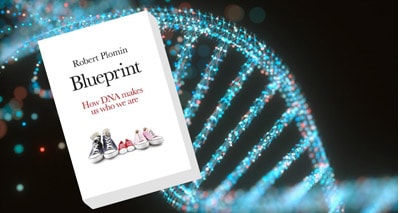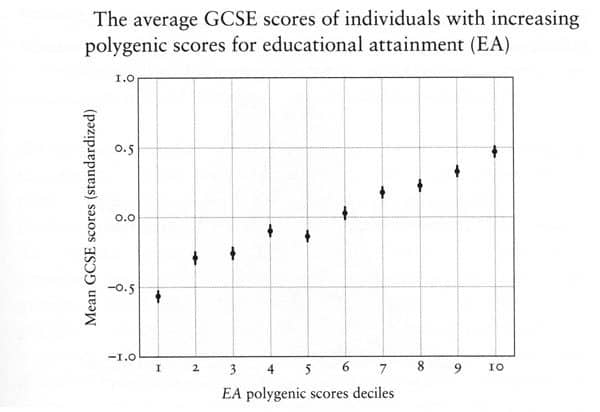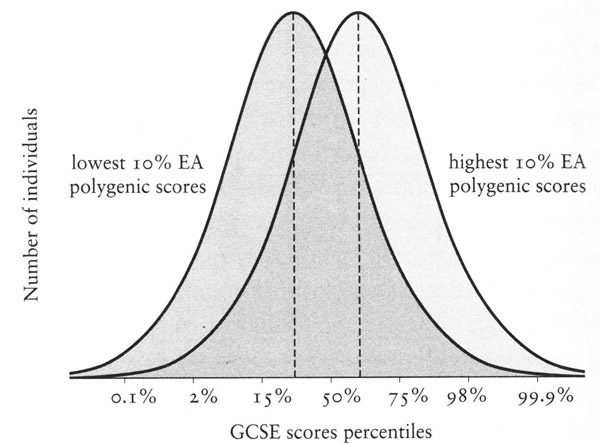Blueprint: How DNA Makes Us Who We Are
Jared Taylor, American Renaissance, January 4, 2019

Robert Plomin, Blueprint: How DNA Makes Us Who We Are, MIT Press, 2018, 266 pp., $24.99.
Blueprint, by psychologist and geneticist Robert Plomin, is one of the most quietly subversive books to appear in many years. The author does not say so specifically, but if his scientific findings were broadly accepted, they would destroy the basis for the entire egalitarian enterprise of the last 60 or so years.
This book summarizes the increasingly powerful evidence that people are inherently — biologically — unequal. As Prof. Plomin puts it: “Genetics is the most important factor shaping who we are. It explains more of the psychological differences between us than everything else put together.” These psychological differences include everything from intelligence to personality to diligence to the ability to learn a foreign language.

Richard Plomin
What is more, although environments affect human abilities and propensities, they act mostly in random, short-term ways that cannot be controlled or predicted. This means that further government intervention in the environment — the leftist panacea for all social ills — will have essentially no effect. Successful people were born with abilities, not unfair “privilege.” Failures were dealt a bad genetic hand. For the most part, we end up where we belong.
There has long been circumstantial evidence from twin and adoption studies of the vital role genes play in making us who we are. Recent breakthroughs — and Prof. Plomin writes at length about them — have found clear genetic patterns associated with everything from intelligence to physical height to schizophrenia. What are known as genome-wide association studies (GWAS) make it possible to look directly at someone’s DNA — even in utero — and predict with increasing accuracy what sort of person he will be.
Prof. Plomin calls this a “revolution” in psychology. “Our future is DNA,” he writes.

What is the environment?
For most of the latter half of the 20th century, it was required to believe that variations in human behavior were caused almost exclusively by differences in environment, especially the home environment. It was acceptable to point out that physical traits such as eye color and height were largely under genetic control, but to say that intelligence had a genetic component was to flirt with Nazism. As Prof. Plomin writes, “[T]hirty years ago it was dangerous professionally to study the genetic origins of differences in people’s behavior and to write about it in scientific journals.”
It was orthodoxy to believe that children resemble their parents in intelligence, income, and social status because of how they are reared. The theory was that if ghetto children could be given middle-class homes, they would become middle-class successes. Many people still believe this.
Some of the most powerful contradictory evidence came from studies of identical twins who were separated at birth and given up for adoption. Although they never lived in the same household, their identical genes give them startlingly similar personalities and behavior. Studies of this kind that date back to the mid-20th century have long calculated that genes account for more than two-thirds of the variance in intelligence, and approximately 50 percent of the variance in personality traits such as agreeableness, conscientiousness, gregariousness, etc. The genetic — rather than environmental — contribution to individual differences of this kind is called “heritability.”

Because these figures are less then 100 percent, it means that the remaining variance must be caused by environment, but it is not family or “shared” environment that makes the difference. Identical twins are no more similar if they are reared in the same home than if they are adopted out to different homes. Adopted children are no more like the biological children of their adopted parents than total strangers are; living in the same home does not make them at all similar to the biological children they grew up with. This leads to the surprising conclusion that, as Prof. Plomin puts it, “Family resemblance is due to DNA rather than to our shared experiences.” We are similar to family members, not because we live with them for years, but because we are genetically related to them.
Prof. Plomin explains what this means: “We would be just as similar to our parents and our siblings even if we had been adopted apart at birth and reared in different families. . . . [E]xperiences shared by family members have no effect on individual differences.” There are a few obvious exceptions to this rule such as regional accent and specialized knowledge that can be strictly environmental. Severe abuse, catastrophic poverty, or malnutrition could also make one family environment so different from others that it would affect a child’s abilities and personality. Prof. Plomin notes that family environment appears to account for about 20 percent of individual variance in religion or politics.
So what are the environmental influences that make identical twins different from each other — and that also accentuate differences between family members? Prof. Plomin explains that they are “not systematic forces like families. . . . [T]hey are mostly random — unsystematic and unstable — which means that we cannot do much about them.” The best guess is that they are purely arbitrary: accidents, disease, or chance encounters with teachers or friends.
Prof. Plomin also explains that we must narrow our understanding of what is genuinely part of the environment because our natures have strong effects on our environments. For example, parents may read more to one child than another, but this probably means that the children differ in how much they like being read to, not that parents deliberately treat them differently. As Prof. Plomin explains, “What appears to be the environmental effect of parenting on children’s psychological development actually involves parents responding to their children’s genetic differences.”
It was long assumed that the number of hours the television was on in a household was part of the environment, but this appears to be about 50 percent heritable. The TV habits of adopted children are more similar to their biological mothers than to those of their adoptive mothers. Likewise, psychologists mistakenly thought that bad experiences were strictly part of the environment. If one identical twin has had a divorce, there is a 55 percent chance that the other twin has, too. The figure for fraternal twins is only 16 percent, which means there is a genetic contribution to divorce. The evidence now strongly suggests that if children of divorced parents are more likely than children of intact families to divorce, it is because of genetic similarity to their parents, not because they experienced a divorce.
Some people have a very supportive circle of friends and others don’t. Psychologists assumed this, too, was strictly environmental, but clearly it is not. People have different numbers of friends and different depths of friendships because they have different personalities that reflect their DNA.
Prof. Plomin also points out that we experience the same environment differently because we have different natures: “Psychological environments are not ‘out there,’ imposed on us passively. They are ‘in here,’ experienced by us as we actively perceive, interpret, select, modify, and even create environments correlated with our genetic propensities.” For example, some people react to bullying by running away and avoiding conflict. Others learn to fight — and may even find they enjoy fighting.
In fact, we make our own environments. As children, we are already absorbing and seeking out experiences outside the home, and by the time we are adults, we arrange our lives — consciously or not — to better reflect our genetic natures. Thus, the heritability of traits increases over time, as we more closely follow the direction in which our genes point us.
When adopted children are small, their IQs have some correlation to those of their adoptive parents who build environments for them, but by the time they are 16, the correlation, in Prof. Plomin’s words, “hovers near zero.” By age 65, after decades of adult choices, the heritability of IQ reaches about 80 percent. The figure of 50 or 60 percent that we often hear is the average over a lifetime. “We grow into our genes,” writes Prof. Plomin.
The search for genes
Prof. Plomin explains that for many years, it was thought that personality traits were controlled by a small number of powerful genes. The theory was that human traits were similar to single-gene disorders, such as Huntington disease, muscular dystrophy, and cystic fibrosis, whose genetic causes were limited and clear. The trick was to find the “genes for intelligence” or for autism.
The search for “candidate genes” failed — because there are no such genes. The current approach is one of brute force: to take huge population samples and search the entire human genome for DNA patterns that correlate with particular traits. We have absolutely no idea how those differences in DNA produce differences in traits — how or whether they code for different proteins or what the chemical pathways are that produce the physiological differences that make us different.
But we now know that there are many DNA differences that contribute in very small ways to individual differences — and the larger the number of people tested, the more accurate the results. Studies of this kind result in DNA scores that predict — but do no more than predict — where an individual will fall on a scale of abilities. These scores are called polygenic scores because they are based on many different small differences in DNA.
Prof. Plomin noted that at the time he was finishing Blueprint, the most accurate polygenic score was for years of schooling completed. This may seem like an odd genetic trait; why not look for something more specific, such as intelligence or conscientiousness? It’s because it takes huge sample sizes to get accurate polygenic scores, and it is easier to learn someone’s educational attainment than to test his IQ or assess conscientiousness.
In a sample of one million people, it was found that more than 1,000 different DNA variations were associated with number of years of schooling, and each one accounted for no more than 0.03 percent of the variance. This resulted in a polygenic score that accounted for 11 percent of the variance.
This may not seem like much — educational attainment appear to be about 50 percent heritable — but in psychology, anything that can predict as much as even 3 or 4 percent of the variance of a trait is colossal. What is more, polygenic scores do not reflect mere correlation; they show causation. Our DNA patterns are present from birth. The number of years we spend in school cannot change them. It is our DNA that gives us the intelligence, persistence, good health, and temperament to get a lot of schooling.
The following two graphs, reproduced from Blueprint, show the predictive power — and the limitations — of the polygenic score for educational attainment when compared with something different: student grades on standardized tests. When the polygenic score is split into deciles, this graph shows the average score for students in each decile on a British standardized test (the GSCE). Clearly, the higher the score, the better a person’s grade on the test.

However, as the second graph shows, there is still a great deal of imprecision. This shows the distribution of test scores for the people in the highest and lowest polygenic deciles. The patterns are perfect bell curves, and the polygenic score is spot on for what is both the modal and average score. However, a subject can score in either the 10th or 90th percentile on polygenic score and still have an actual standardized test score anywhere within the possible range of scores. As Prof. Plomin notes, at current levels of accuracy, polygenic scores are very good at predicting averages, but predict only tendencies for individuals.

That will change. This polygenic score predicts only 11 percent of a variance — educational attainment — out of about 50 percent that is heritable, and it is being used to predict something related but different: standardized test scores. As DNA test methods are refined and as sample sizes increase, it should eventually be possible to find DNA patterns that account for nearly all of the variances in traits that kinship studies have shown to be heritable. And this information will be available even before birth.
Spectra of abnormality
One of the surprises in recent DNA research was the discovery that abnormalities such as schizophrenia and bipolar disorder are like other human traits: determined by large numbers of genetic patterns that each contribute only slightly to the trait. Thus there are no “genes for depression,” only patterns that make it more or less likely. This means there are no clear cut-off points for diagnosis. Behavior and personality are on spectra. We all have combinations of traits that if taken to the extreme would make us highly likely to have a personality disorder. This is reflected in the increasingly common use of expressions such as “autism spectrum.”
Prof. Plomin notes that research in this area has concentrated on the extreme polygenic scores that are associated with a disorder. However, the other extremes are worth studying, too. All polygenic scores have a normal distribution, but it may not be best to be at the opposite extreme on the distribution for likelihood to be bipolar, for example. The opposite of manic depression might not be consistent cheerfulness but an inability to experience joy or sorrow. An extreme score for conscientiousness might mean a good chance of obsessive-compulsive disorder. Unlike the spectra for intelligence, it may be best to score close to the average for most traits. At the same time, some disorders may be good in moderation; schizophrenia is associated with creativity.
Prof. Plomin makes it clear that high polygenic scores for disorders are, again, only tendencies. It might require some powerful, genuinely environmental effect to push someone over the edge, even if he is at the polygenic extreme. As noted above, how we react to our environments is mediated by genes. However, increasingly accurate polygenic scores could be very useful. If parents know early on that their children differ in academic ability or temperament, they shouldn’t try to force them all to reach the same level. If parents know that a child has a tendency to obesity or alcoholism, they can try to counter these tendencies early on. Many psychological problems are much harder to cure once they are fully developed.
The power of DNA
The recognition of the power of DNA has many consequences. Prof. Plomin points out that since parents — despite their sincere belief and every effort — have little influence on their children other than the DNA they pass on, they should not try to mold them. Parents should approach children as they do friends; enjoy them for who they are and not try to change them.
Prof. Plomin also argues that an understanding of DNA should make us much more skeptical of the value of selective schools. He says that of course their graduates do well; they were smart to begin with and would do well wherever they went. He argues that the genuine value added of an Ivy League school is negligible.

“Yale: not much value added.”
Of much greater consequence is the fact that aside from violence or extreme poverty, rearing environments don’t make much difference in how we turn out. As Prof. Plomin notes, even “inherited wealth is not much related to occupational status or to income” because genes send people both up and down the social ladder; we end up where our genes send us. Environment matters, but in unpredictable ways we can’t control. “Environmental levers for change,” explains Prof. Plomin, “are not within our grasp.”
This is a devastating finding for the armies of academics and uplift artists who think every difference in outcome is society’s fault, and who think government should be infinitely expanded to fight for “social justice.” And, although Blueprint includes nothing about race, the implications for “racial justice” are just as colossal.
Prof. Plomin sees very well where his findings lead — and doesn’t want us going that way. This spring, the paperback edition of Blueprint will include the following sentence: “There are powerful methods for studying the genetic and environmental origins of individual differences, but not for studying the causes of average differences between groups.” Alas, even a non-scientist knows that’s unlikely to be true. Aren’t comparisons of polygenic scores between races and sexes and other groups a “powerful method” for studying group differences?
It is impossible to know what Prof. Plomin believes in his heart. The hideous treatment Nobel laureate James Watson got for speculating very reasonably about racial differences is a strong message to even the bravest scientist about the limits of free speech.
Science marches on, whatever we think or expect. Where we dare not tread, the Chinese will. Slowly the edifice of white guilt is crumbling.















